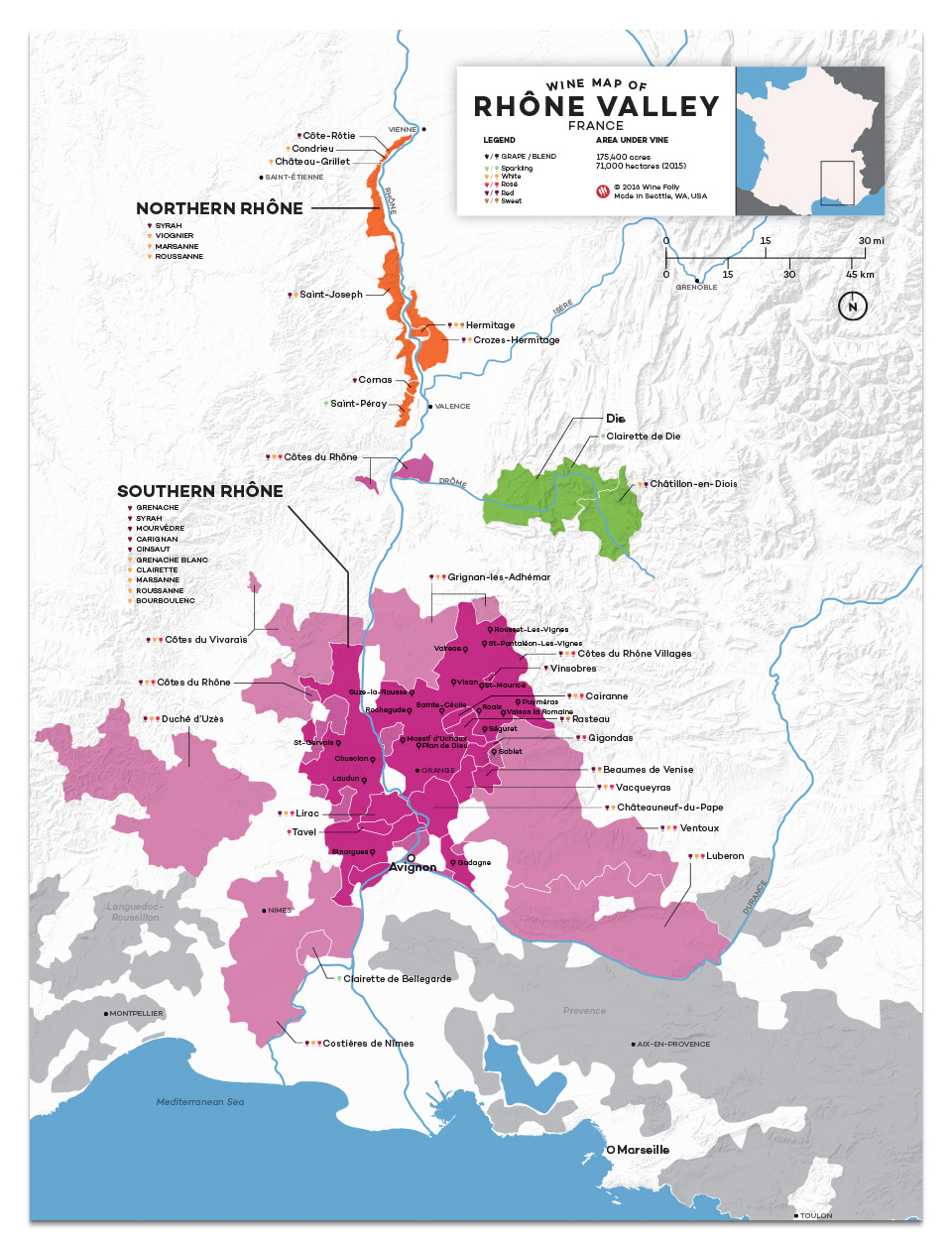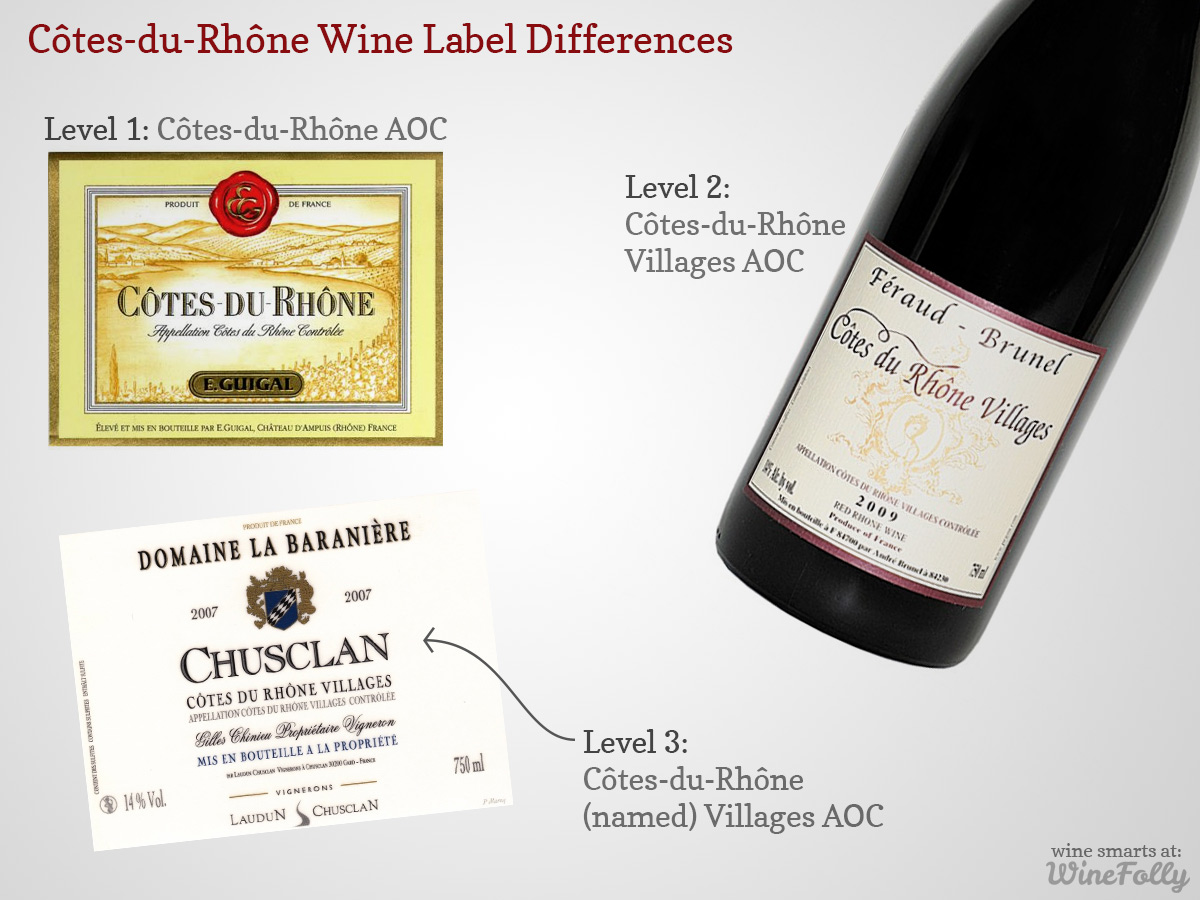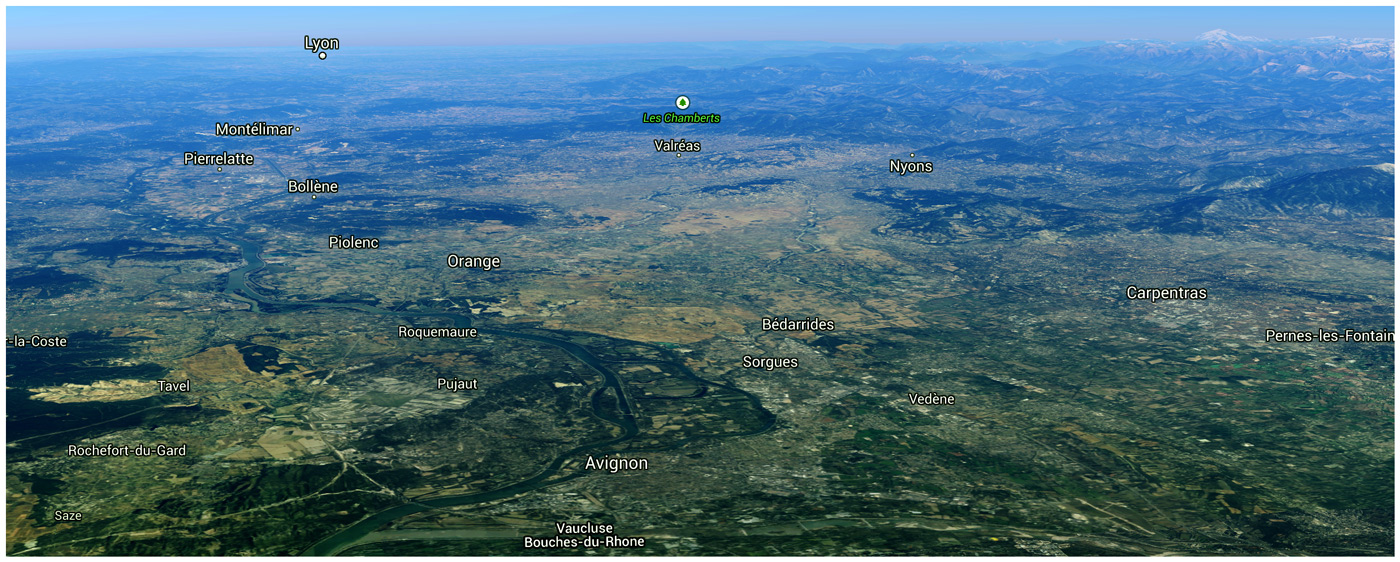The Rhône Valley has been a hub of wine culture since ancient times and is just as popular today. Explore this superb region and learn why: “There’s no place like Rhône.”
Viticulture as we know it arrived in Southern France with the Greeks in the 4th century BC. But it was the Romans who really established the vineyards and reputation of the area using the Rhône as their highway through France (and planting a few vineyards along the way).
Châteauneuf-du-Pape means “The Pope’s New Castle.” The Catholic Church was the next main influence when Pope Clement V moved his headquarters from Rome to Avignon in 1309.
Wine Quality Levels in Côtes du Rhône Wine
The wines of the Rhône Valley are divided into four levels:
Côtes du Rhône AOC
This entry-level classification accounts for about two-thirds of the valley’s production. Most are red blends based on Grenache or Syrah, and the vineyards are planted on various soils. Production rules are not as strict as other levels. Still, wines must have a minimum of 11% alcohol and be made from the 21 sanctioned grape varieties (although the Côtes du Rhône Villages AOC recognizes 24 grape varieties).
These easy-drinking, food-loving wines are perfect for everyday use. The white blends and rosés are equally delicious, too, even if a little harder to find.
Côtes du Rhône Villages AOC
This is the next step up in wine’s ‘pyramid.’ Village wines are a bit more complex, with lower yields and slightly higher alcohol. They are great for aging.
Côtes du Rhône (named) Villages AOC
Keep an eye out for labels bearing one of the 21 villages that are able to declare their names. In alphabetical order (current to 2025):
- Chusclan
- Gadagne
- Massif d’Uchaux
- Nyons
- Plan de Dieu
- Puyméras
- Roaix
- Rochegude
- Rousset-les-Vignes
- Sablet
- Saint-Andéol
- Saint-Gervais
- Saint-Maurice
- Saint-Pantaléon-les-Vignes
- Sainte-Cécile
- Séguret
- Signargues
- Suze-la-Rousse
- Vaison-la-Romaine
- Valréas
- Visan
The Crus
These 20 distinctive crus of the Rhône Valley truly express their individual “terroir” and are responsible for about 20% of the Rhône wine production.
- Beaumes-de-Venise AOC
- Cairanne AOC
- Château-Grillet AOC
- Châteauneuf-du-Pape AOC
- Condrieu AOC
- Cornas AOC
- Côte-Rôtie AOC
- Crozes-Hermitage AOC
- Gigondas AOC
- Hermitage AOC
- Laudun AOC (Rhône’s newest Cru, elevated from Côtes du Rhône Villages in 2024)
- Lirac AOC
- Rasteau AOC
- Saint-Joseph AOC
- Saint-Péray AOC
- Tavel AOC
- Vacqueyras AOC
- Vinsobres AOC
- Vin doux naturel Muscat de Beaumes-de-Venise AOC
- Vin doux naturel Rasteau AOC
- Clairette de Die AOC, known for its gently sparkling Muscat-based wines made with the ancestral method.
- Crémant de Die AOC, a dry traditional-method sparkling wine.
- Coteaux de Die AOC, a rare still white wine made entirely from Clairette.
Additionally, while not adjacent to the Rhône River, Diois is a small, high-altitude wine region in the Drôme department and is administratively part of the Rhône wine region. This area specializes in three appellations:

What the Rhône Valley Region Is Like
The Rhône Valley was created during the last ice age as the Rhône Glacier carved its way south through what is now France. Today, the Rhône River begins in the Alps and meanders for 505 miles (813 km) to the Mediterranean Sea.

The vineyards are located on both sides of the river between Vienne and Avignon, just south of Lyon. The Northern and Southern Rhône are unique, each with vastly different geography, climate, soils, and grape varieties, but they share one thing in common – the Rhône River.
THE NORTHERN RHÔNE
The Northern Rhône is a mere 40 miles (64 km) long and is responsible for a tiny 4-5% of all the wines from the region. The climate is ‘Continental’ — hot summers, cold winters, and moderate annual rainfall of roughly 23-32 inches (600–800 mm), most of it falling in spring and autumn rather than during the key ripening months.
A defining climatic force here is the Mistral — a fierce, cold, dry wind that barrels down the Rhône valley from the north. It can howl for days, scouring the sky of clouds, lowering humidity, and greatly reducing disease pressure. The trade-off is its strength: growers often have to stake or guyot-train their vines so they don’t snap in the gusts.
The most striking feature of the landscape is the sheer steepness of the hillsides. Terraced vineyards keep the soil from eroding, capture and reflect the sun’s warmth, and make life a little easier for the vineyard workers!
This is the birthplace of Syrah and, for many wine lovers, the place where the grape reaches its greatest expression — full-bodied, savory, and elegant.
NORTHERN RHÔNE CRUS
Côte Rôtie
The “Roasted Slope” is home to some of the steepest vineyards in all of France. Syrah loves the well-draining granite soils and soaks up the sun on the south-facing slopes. Wines from here can be pricey but worth it – raspberry, violet, truffles, and chocolate are just some of the delicious descriptors!
Condrieu and Château Grillet
Condrieu (Con-dree-euh) and the tiny vineyards of Château Grillet are best known for the luscious wines of Viognier. This is the home of Viognier and, at one time, was the only place to find it. Again, not the least expensive of wines but something to savor – heady apricot, floral notes, and a rich honeyed mouthfeel. I like to call it the ‘cashmere sweater’ of white wines!
Saint-Joseph
The largest of the Northern AOCs, Saint-Joseph is home to Syrah and the white varietals Roussanne and Marsanne. The whites are fresh with subtle fruit and floral notes, while the Syrah is lovely and perfumey with dark berries and a bit of licorice. Great with everyday meals, they are eminently drinkable and can be enjoyed without years of aging.
Cornas
This may be the smallest red AOC in size, but Cornas wines are big and powerful! Spicy, earthy, chocolatey, and deep, wines are made for aging, if you can resist!
Saint-Péray
Only white and sparkling wines from Marsanne and Roussanne in this AOC! The vineyards lie on extremely steep slopes on either side of a deep valley, creating a slightly warmer microclimate, giving us zesty sparklers made in the traditional Champenoise method. The still whites are equally refreshing – terrific before a meal.
Crozes-Hermitage
The biggest area in terms of production, Crozes-Hermitage often lies in the shadow of the famous ‘Hermitage’ AOC it surrounds. Wines are produced from Syrah, with Marsanne and Roussanne, and range from easy drinking to cellar worthy. Look for famous names like Chapoutier, Jaboulet, and Cave de Tain.
Hermitage
Famous worldwide, the wines from Hermitage come from the small vineyards overlooking the village of Tain-l’Hermitage.
Most of the production is Syrah, and the wines need some time to show their true character – round and full-bodied with red fruits, wild flowers, and leather. The whites are harder to find and were once the favorite of the Russian nobility.
SOUTHERN RHÔNE CRUS
As the Rhône River progresses southward, the valley widens and the climate changes. The region is distinctly more ‘Provençal’ with a Mediterranean influence in culture and climate. The summers are long and warm, and the winters are mild; rainfall is less than in the north, and the famous Mistral Wind is a major player. Another unique characteristic of these wines is the nuances of Garrigue – the wild resinous herbs that cover the landscape.
A Wind So Miserable It’s Named “The Mistral”
The Mistral is more than just a cold, fierce wind that blows from the Northern seas; it’s an important part of the culture of southern France and Provence. Mistral winds blow at an average speed of 60 mph (hurricanes start at 70!) and do so about 150 days of the year, mostly from winter to early spring.
The bad part is that they can be very destructive, damaging or uprooting vines, but they have a good influence too. The winds are always followed by clear, bright skies, providing abundant sunshine for the vines. They blow fungus-loving moisture from the grape clusters and, in summer, bring welcome cooler temperatures.
If Syrah reigns in the north, Grenache is the King in the south, forming the foundation of the area’s popular blends. You’ll also encounter Mourvèdre, Cinsault, Counoise, Carignan, Grenache Blanc, Marsanne, Roussanne, Clairette, Bourboulenc, and several minor players.
Côtes du Rhône AOC
This is the largest AOC and accounts for two-thirds of Rhône production. Full-bodied reds dominate, but the luscious whites and thirst-quenching rosés are well worth seeking out.
Gigondas
The Roman legions knew about the great wines from this area! With its hot climate, abundant sunshine, and the Dentelle Mountains protecting vineyards from the Mistral, the predominantly red wines from Gigondas are full, earthy, and aromatic.
Vacqueyras
Named after the Latin for “Valley of the Rocks,” the Vacqueyras lie next to Gigondas. The wines are Grenache-dominant with aromas of small red fruits and violets that age into licorice, pepper, and spice.
Vinsobres
Higher altitudes and various soil types result in inky red wines with black cherry, jammy fruit, and lots of tannin. Only reds are produced here, from Grenache with Syrah or Mourvèdre.
Beaumes de Venise
This is another ancient region, settled by the Greeks and home to the famous sweet wine “Muscat de Beaumes de Venise”. The vineyards are planted on steep hillsides terraced with manufactured walls of local river rocks called ‘restanque’. In 2005, the region was sanctioned for red wines from Grenache and Syrah that are full of deep fruits and spice.
Rasteau
Another region famous for its sweet “Vin Doux.” Rasteau has been producing its famous Grenache-based fortified wine for hundreds of years. Today, more producers are making fantastic dry wines.
Lirac
Low rainfall and plentiful sun have made the region of Lirac a prime vineyard area for two thousand years. This is where the term ‘Côtes du Rhône’ was first marked on barrels for export – a guarantee of authenticity still used today.
Lirac produces aromatic, structured, and elegant wines with black fruit, truffle and cocoa notes in the reds, deep berry red fruits in the rosés and fresh, aromatic whites.
Tavel
Located just south of Lirac, Tavel’s vineyards date back to the Greek era and the 5th century BC.
During the Middle Ages, the south of France was a popular holiday retreat for the Popes, and they loved the refreshing rosé wines that came from this region so much that they decreed that nothing else should be produced. To this day, Tavel is synonymous with rosé — in fact, they have dubbed themselves “Le Roi des Rosés” – “ The King of Rosés”.
The vineyards are home to nine varieties in three distinct soil types:
sharp, flat slabs of limestone called “Les Vestides”, pebbly soils called “Vallongue” and “Olivet”, a mixture of sand and stone. Each contributes its own influence to the wines, creating rosé with a deep pink hue, lots of red fruits, berry, and stone fruit flavors.
Châteauneuf-du-Pape
The most famous of the Rhône Valley AOCs is Châteauneuf-du-Pape. This was the first AOC to become official when the system was instituted in 1936.
The vineyards grow 14 varieties (20 if you count the variations!) at four levels of altitude as the land rises from the Rhône River. The soils are varied, the most famous being the large, rolled river stone or “Galets” left behind a million years ago by ancient glaciers. Want to know more? Check out this Châteauneuf-du-Pape explainer.
Red wines are the most plentiful, including Grenache and Cinsault with Mourvèdre, Syrah, and other allowable reds, producing full and aromatic wines with spicy dark fruits balanced with acidity and minerality.
Whites make up a small 5–6% of production, but are worth trying. They speak of the warm southern climate, with honeysuckle, stone fruits, and melon, backed with refreshing minerality.
Cairanne
Recognized as a cru in 2016, Cairanne produces structured reds with ripe black fruit, savory herbs, and a streak of freshness from its hillside vineyards. Grenache dominates, with Syrah and Mourvèdre adding depth. The region’s stony soils and varied exposures make for complex, age-worthy wines that balance power and finesse.
Laudun
The Rhône’s newest cru, Laudun lies on the right bank of the Rhône and is known for both reds and whites. Reds blend Grenache, Syrah, and Mourvèdre with elegance and lift. Whites, often based on Grenache Blanc and Clairette, are floral, textured, and increasingly prized for their quality.
Other Côtes du Rhône Wines
Costières de Nimes
Slightly cooler thanks to sea breezes from the Mediterranean, this area produces whites, reds, and rosés that are big in fragrance, lower in tannin, and quaffable.
Coteaux de Tricastin / Grignan-les-Adhémar
Recognized initially as Coteaux de Tricastin in 1973, this region was allowed to change its name in 2012. It seems that a nuclear power plant with the same name had a meltdown in 2008 — not a marketer’s dream! Whites, reds, and rosés and home of truffles!
Ventoux
Named after the famous Mont Ventoux, this region produces bold wines that show their terroir – reds with lots of pepper, spice and dark fruit, aromatic whites and full-bodied rosé. Native garrigue and lavender are significant influences.
Côtes du Luberon
With a more Mediterranean influence, the sunny, hot weather produces deep and bold wines, with lots of black fruit, leather, and licorice.
Côte du Vivarais
In the northern section of the southern Rhône, the Côte du Vivarais produces robust Syrah and Grenache-dominant blends, deep rosés, and fresh, mineral-driven white wines.

